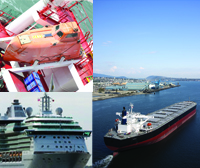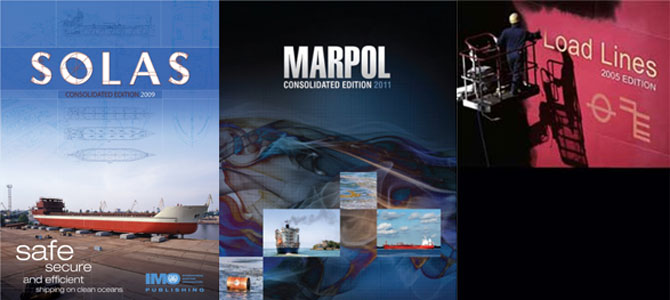A number of amendments to SOLAS, MARPOL and the 1988 Load Lines Protocol entered into force or took effect from 1 January 2014.

A number of amendments to the International Convention for the Safety of Life at Sea (SOLAS), the International Convention for the Prevention of Pollution from Ships (MARPOL) and the 1988 Load Lines Protocol entered into force or took effect from 1 January 2014.
----
The amendments cover passenger ship safety (in relation to safe return to port after a flooding casualty); the testing of free-fall lifeboats; minimum safe manning levels; prohibition of blending onboard; the revised MARPOL Annex III; the United States Caribbean Sea Emission Control Area; and the Winter Seasonal Zone off the southern tip of Africa.
2012 May SOLAS amendments
The SOLAS amendments which entered into force on 1 January 2014 include the following:
The SOLAS amendments which entered into force on 1 January 2014 include the following:
- amendment to SOLAS regulation II-1/8-1, to introduce a mandatory requirement for new passenger ships for either onboard stability computers or shore-based support, for the purpose of providing operational information to the Master for safe return to port after a flooding casualty;
- amendment to SOLAS regulation III/20.11.2 regarding the testing of free-fall lifeboats, to require that the operational testing of free-fall lifeboat release systems shall be performed either by free-fall launch with only the operating crew on board or by a simulated launching;
- amendment to SOLAS chapter V to add a new regulation V/14 on ships' manning, to require Administrations, for every ship, to establish appropriate minimum safe manning levels following a transparent procedure, taking into account the guidance adopted by IMO (Assembly resolution A.1047(27) on Principles of minimum safe manning); and issue an appropriate minimum safe manning document or equivalent as evidence of the minimum safe manning considered necessary;
- amendment to SOLAS chapter VI to add a new regulation VI/5-2, to prohibit the blending of bulk liquid cargoes during the sea voyage and to prohibit production processes on board ships;
- amendment to SOLAS chapter VII to replace regulation 4 on documents, covering transport information relating to the carriage of dangerous goods in packaged form and the container/vehicle packing certificate; and
- amendment to SOLAS regulation XI-1/2 on enhanced surveys, to make mandatory the International Code on the Enhanced Programme of Inspections during Surveys of Bulk Carriers and Oil Tankers, 2011 (2011 ESP Code, resolution A.1049(27)).
2010 October MARPOL amendments
The amendments which entered into force on 1 January 2014 include a revised MARPOL Annex III Regulations for the prevention of pollution by harmful substances carried by sea in packaged form, to include changes to the Annex to coincide with the next update of the mandatory International Maritime Dangerous Goods (IMDG) Code, specifying that goods should be shipped in accordance with relevant provisions.
The amendments which entered into force on 1 January 2014 include a revised MARPOL Annex III Regulations for the prevention of pollution by harmful substances carried by sea in packaged form, to include changes to the Annex to coincide with the next update of the mandatory International Maritime Dangerous Goods (IMDG) Code, specifying that goods should be shipped in accordance with relevant provisions.
United States Caribbean ECA now effective
The United States Caribbean Sea Emission Control Area (SOx, NOx and PM) came into effect, under MARPOL Annex VI, on 1 January 2014, bringing in stricter controls on emissions of sulphur oxide (SOx), nitrogen oxide (NOx) and particulate matter for ships trading in certain waters adjacent to the coasts of Puerto Rico and the United States Virgin Islands.
The United States Caribbean Sea Emission Control Area (SOx, NOx and PM) came into effect, under MARPOL Annex VI, on 1 January 2014, bringing in stricter controls on emissions of sulphur oxide (SOx), nitrogen oxide (NOx) and particulate matter for ships trading in certain waters adjacent to the coasts of Puerto Rico and the United States Virgin Islands.
The ECA was designated under MARPOL amendments adopted in July 2011. There are now four designated ECAs in effect globally: the United States Caribbean Sea ECA and the North American ECA; and the sulphur oxide ECAs in the Baltic Sea area and the North Sea area.
(See: MARPOL Annex VI regulation 14)
(See: MARPOL Annex VI regulation 14)
Coordinates for the Caribbean Sea ECA can be found in Resolution MEPC.202(62).
Winter Seasonal Zone moved south under amendments to LL Protocol
Amendments to regulation 47 of the 1988 Protocol to the International Convention on Load Lines (LL), 1966 to shift the Winter Seasonal Zone off the southern tip of Africa further southward by 50 miles, came into effect on 1 January 2014.
